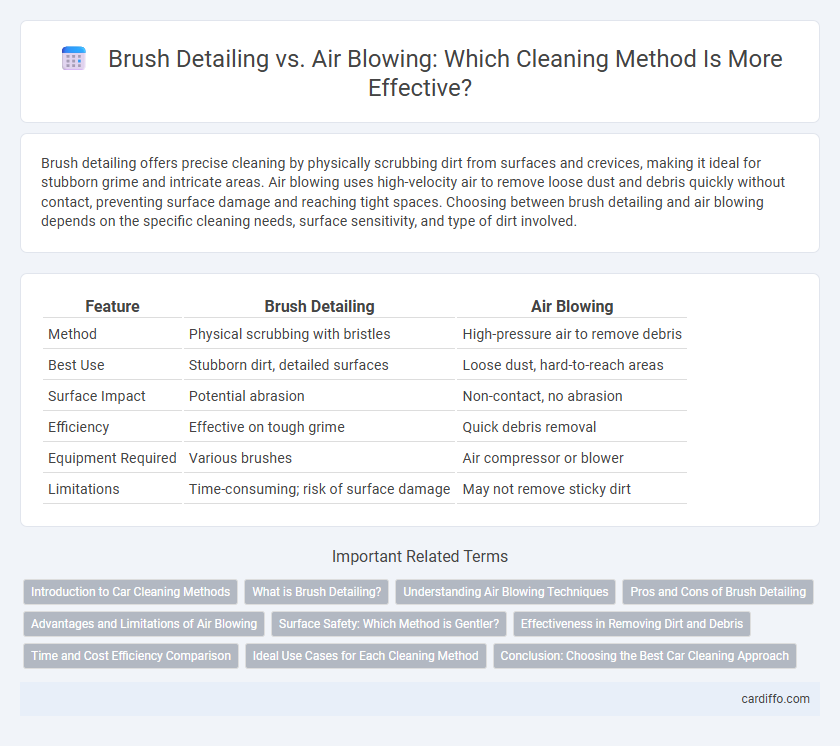Brush detailing offers precise cleaning by physically scrubbing dirt from surfaces and crevices, making it ideal for stubborn grime and intricate areas. Air blowing uses high-velocity air to remove loose dust and debris quickly without contact, preventing surface damage and reaching tight spaces. Choosing between brush detailing and air blowing depends on the specific cleaning needs, surface sensitivity, and type of dirt involved.
Table of Comparison
| Feature | Brush Detailing | Air Blowing |
|---|---|---|
| Method | Physical scrubbing with bristles | High-pressure air to remove debris |
| Best Use | Stubborn dirt, detailed surfaces | Loose dust, hard-to-reach areas |
| Surface Impact | Potential abrasion | Non-contact, no abrasion |
| Efficiency | Effective on tough grime | Quick debris removal |
| Equipment Required | Various brushes | Air compressor or blower |
| Limitations | Time-consuming; risk of surface damage | May not remove sticky dirt |
Introduction to Car Cleaning Methods
Brush detailing offers precise control for removing dirt from intricate surfaces, making it ideal for thorough car cleaning. Air blowing uses high-pressure air to dislodge dust and debris from hard-to-reach areas without physical contact, minimizing the risk of scratches. Choosing between brush detailing and air blowing depends on the type of dirt and the vehicle's surface sensitivity.
What is Brush Detailing?
Brush detailing involves using fine, specialized brushes to meticulously clean surfaces, removing dirt, dust, and grime from hard-to-reach areas such as crevices and textured surfaces. This method excels in providing deep cleanliness and precision, especially on delicate or intricate objects like car interiors, electronic devices, and upholstery. Brush detailing ensures thorough removal of particles stuck in tight spaces, enhancing both appearance and hygiene without causing damage.
Understanding Air Blowing Techniques
Air blowing techniques utilize compressed air to remove dust and debris from hard-to-reach surfaces, providing a gentle and residue-free cleaning method ideal for delicate equipment. Compared to brush detailing, air blowing reduces the risk of surface scratching and is faster for cleaning intricate components such as electronic devices or automotive interiors. Effective air blowing requires adjustable nozzles and controlled pressure to optimize debris removal without causing damage.
Pros and Cons of Brush Detailing
Brush detailing offers precise control for removing dirt and grime from small crevices and intricate surfaces, making it ideal for delicate items and automotive interiors. However, it can be time-consuming and may cause scratches or damage if too much pressure is applied or if the brush is not appropriately chosen. Unlike air blowing, brush detailing provides tactile feedback, ensuring thorough cleaning but requires careful technique to avoid wear and tear.
Advantages and Limitations of Air Blowing
Air blowing in cleaning effectively removes loose dust and debris from hard-to-reach areas without physical contact, reducing the risk of surface damage. It offers efficient drying and debris removal for electronic components and delicate surfaces but struggles with sticky or embedded dirt that requires mechanical agitation. Limitations include noise generation, potential dispersal of allergens, and reduced effectiveness on wet or greasy residues compared to brush detailing.
Surface Safety: Which Method is Gentler?
Brush detailing offers precise control and effective removal of dirt from delicate surfaces without causing abrasions, making it ideal for fragile materials. Air blowing, while non-contact and reducing the risk of surface scratches, can sometimes force contaminants into crevices or damage soft materials with high pressure. For optimal surface safety, selecting brush detailing with soft bristles usually ensures gentler cleaning compared to high-pressure air blowing.
Effectiveness in Removing Dirt and Debris
Brush detailing provides superior effectiveness in removing embedded dirt and stubborn debris from surfaces thanks to its physical agitation, which dislodges particles trapped in crevices and textured areas. Air blowing excels at clearing loose dust and lightweight debris quickly from flat or open surfaces but struggles with grime adhered to textured or irregular areas. Combining both methods often yields optimal cleanliness by leveraging the deep-cleaning power of brushes and the swift debris removal of air blowing.
Time and Cost Efficiency Comparison
Brush detailing offers precise cleaning for intricate surfaces but requires more time and labor, increasing overall cost. Air blowing delivers faster debris removal with less manual effort, reducing operational time and expenses. Choosing air blowing maximizes time and cost efficiency in routine cleaning tasks.
Ideal Use Cases for Each Cleaning Method
Brush detailing excels in removing grime from textured surfaces and tight crevices, making it ideal for automotive interiors and intricate household items. Air blowing efficiently dislodges dust and debris from delicate electronics and hard-to-reach areas without physical contact, reducing the risk of damage. Choosing brush detailing suits thorough manual cleaning, while air blowing favors quick, non-abrasive dust removal in sensitive environments.
Conclusion: Choosing the Best Car Cleaning Approach
Brush detailing offers precision and thoroughness by physically removing dirt from intricate surfaces, making it ideal for stubborn grime and textured areas. Air blowing excels in reaching tight spaces and quickly dislodging loose debris without abrasion, preserving delicate components. Selecting the best car cleaning method depends on the specific cleaning task, surface sensitivity, and desired level of detail to ensure optimal vehicle maintenance.
Brush Detailing vs Air Blowing Infographic

 cardiffo.com
cardiffo.com